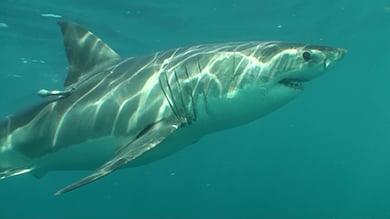Species and classification
The table below lists the threatened and at risk species that have been observed in the marine reserve. The species are classified using the New Zealand Threat Classification System.
|
Common and Māori name |
Species |
Threat status |
|---|---|---|
|
Great white shark, mangō taniwha, mangō ururoa |
Carcharodon carcharias |
Gradual decline |
|
Bottlenose dolphin, terehu |
Tursiops truncatus |
Nationally Endangered |
|
New Zealand sealion/pakake/whakahao |
Phocarctos hookeri |
Nationally Critical |
|
Black corals |
Antipathidae spp. |
Range restricted |
|
Hoiho, yellow-eyed penguin |
Megadyptes antipodes |
Nationally Vulnerable |
|
Fiordland crested penguin, tawaki |
Eudyptes pachyrhynchus |
Nationally Endangered |
|
Little penguin, kororā |
Eudyptula minor |
Declining |
|
Southern New Zealand dotterel, tūturiwhatu |
Charadrius obscurus Obscurus |
Nationally Critical |
|
White-fronted tern, tara |
Sterna striata |
Declining |
|
Stewart Island shag, kawau |
Leucocarbo chalconotus |
Nationally Vulnerable |
|
Pied shag, karuhiruhi |
Phalacrocorax varius |
Nationally Vulnerable |
|
Variable oystercatcher, tōrea pango |
Haematopus unicolor |
Recovering |
Great white voyagers

Great white shark
Image: Clinton Duffy ©
Electronic tracking tags are revealing the secrets of the great white sharks that live around Stewart Island and visit the marine reserve.
DOC shark researcher Clinton Duffy says, “While I had some records of white sharks from Paterson Inlet before the start of the research, we had no knowledge of how often they occurred there. We found that the sharks spend most of their time at the Titi/Muttonbird Islands but from time to time make short excursions (sometimes several at once) into the mouth of the inlet, with a few moving further into it.”
The tags have also tracked the Stewart Island sharks travelling to subantarctic islands, eastern Australia, the Coral Sea, New Caledonia, Vanuatu, Fiji and Tonga – and back again. It’s not uncommon for a shark to travel 100 km per day.
“We expected to see sharks travelling between New Zealand and southern Australia, but we had no idea about the details. We found they go much further north, moving seasonally to northern New South Wales, the southern Great Barrier Reef and the Coral Sea.”
Videos
Big fish, calm sea – white shark tagging off Stewart Island.
A great white shark in Ulva Island/Te Wharawhara Marine Reserve, filmed by the DOC team during their survey work.
Reports
- New Zealand’s great white sharks: how science is revealing their secrets, by Alison Ballance. Publisher: Potton & Burton, 2017.
- Spatial and temporal habitat use by white sharks (Carcharodon carcharias) at an aggregation site in southern New Zealand. By Malcolm Francis, Clinton Duffy and Warwick Lyon (2015).
- Regional population connectivity, oceanic habitat, and return migration revealed by satellite tagging of white sharks, Carcharodon carcharias, at New Zealand aggregation sites. By Clinton Duffy, Malcolm Francis et al (2012) in Global Perspectives on the Biology and the Life History of the White Shark, CRC Press 301–318.
- The third dimension: vertical habitat use by white sharks, Carcharodon carcharias, in New Zealand and in oceanic and tropical waters of the southwest Pacific Ocean. By Malcolm Francis, Clinton Duffy et al (2012) in Global Perspectives on the Biology and the Life History of the White Shark. CRC Press 319–342.
- Stewart Island/Rakiura Conservation Management Strategy and Rakiura National Park Management Strategy (PDF, 2.850K).